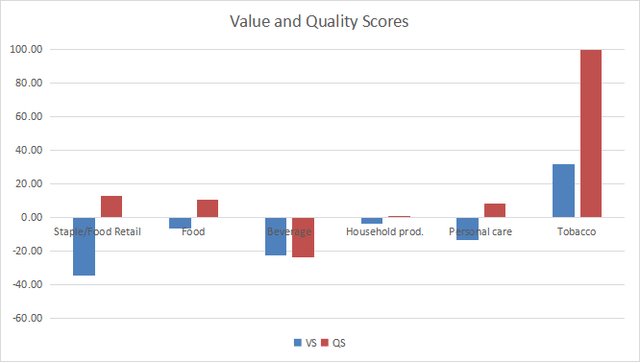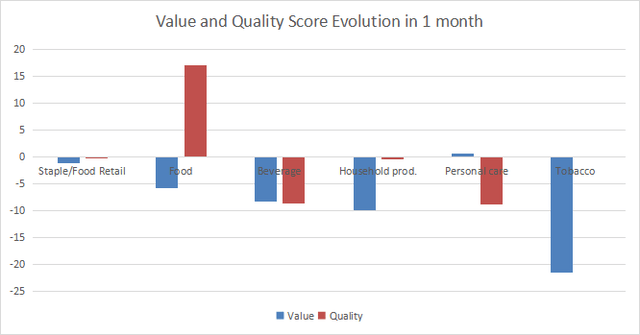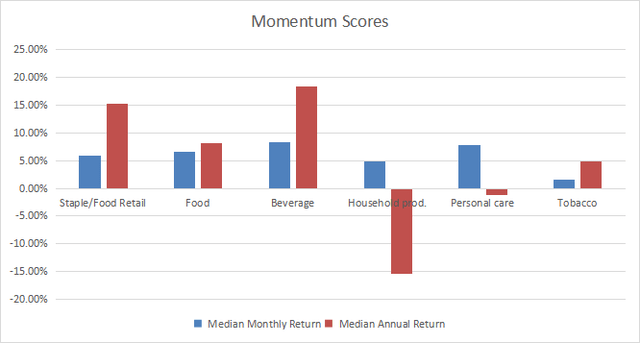SDI Productions
This monthly article series shows a dashboard with aggregate industry metrics in consumer staples. It may also serve as a top-down analysis of sector ETFs like the Consumer Staples Select Sector SPDR ETF (XLP) and the Vanguard Consumer Staples ETF (NYSEARCA:VDC), whose largest holdings are used to calculate these metrics.
Shortcut
The next two paragraphs in italic describe the dashboard methodology. They are necessary for new readers to understand the metrics. If you are used to this series or if you are short of time, you can skip them and go to the charts.
Base Metrics
I calculate the median value of five fundamental ratios for each industry: Earnings Yield (“EY”), Sales Yield (“SY”), Free Cash Flow Yield (“FY”), Return on Equity (“ROE”), Gross Margin (“GM”). The reference universe includes large companies in the U.S. stock market. The five base metrics are calculated on trailing 12 months. For all of them, higher is better. EY, SY and FY are medians of the inverse of Price/Earnings, Price/Sales and Price/Free Cash Flow. They are better for statistical studies than price-to-something ratios, which are unusable or non available when the “something” is close to zero or negative (for example, companies with negative earnings). I also look at two momentum metrics for each group: the median monthly return (RetM) and the median annual return (RetY).
I prefer medians to averages because a median splits a set in a good half and a bad half. A capital-weighted average is skewed by extreme values and the largest companies. My metrics are designed for stock-picking rather than index investing.
Value and Quality Scores
I calculate historical baselines for all metrics. They are noted respectively EYh, SYh, FYh, ROEh, GMh, and they are calculated as the averages on a look-back period of 11 years. For example, the value of EYh for food in the table below is the 11-year average of the median Earnings Yield in food companies.
The Value Score (“VS”) is defined as the average difference in % between the three valuation ratios (EY, SY, FY) and their baselines (EYh, SYh, FYh). The same way, the Quality Score (“QS”) is the average difference between the two quality ratios (ROE, GM) and their baselines (ROEh, GMh).
The scores are in percentage points. VS may be interpreted as the percentage of undervaluation or overvaluation relative to the baseline (positive is good, negative is bad). This interpretation must be taken with caution: the baseline is an arbitrary reference, not a supposed fair value. The formula assumes that the three valuation metrics are of equal importance.
Current data
The next table shows the metrics and scores as of last week’s closing. Columns stand for all the data named and defined above.
|
VS |
QS |
EY |
SY |
FY |
ROE |
GM |
EYh |
SYh |
FYh |
ROEh |
GMh |
RetM |
RetY |
|
|
Staple/Food Retail |
-34.54 |
12.71 |
0.0332 |
1.7268 |
0.0098 |
22.13 |
20.53 |
0.0434 |
1.9302 |
0.0322 |
16.53 |
22.43 |
5.95% |
15.31% |
|
Food |
-6.74 |
10.72 |
0.0541 |
0.5601 |
0.0197 |
20.95 |
28.34 |
0.0461 |
0.6801 |
0.0246 |
15.31 |
33.51 |
6.67% |
8.09% |
|
Beverage |
-22.43 |
-23.58 |
0.0321 |
0.2364 |
0.0104 |
18.72 |
40.75 |
0.0370 |
0.2681 |
0.0180 |
24.57 |
53.17 |
8.38% |
18.40% |
|
Household prod. |
-3.44 |
0.91 |
0.0665 |
1.1002 |
0.0056 |
18.25 |
38.89 |
0.0444 |
0.8759 |
0.0392 |
17.11 |
40.87 |
4.82% |
-15.44% |
|
Personal care |
-13.27 |
8.61 |
0.0368 |
0.3791 |
0.0166 |
22.11 |
63.17 |
0.0385 |
0.4577 |
0.0203 |
21.53 |
55.16 |
7.87% |
-1.12% |
|
Tobacco |
31.93 |
100* |
0.0622 |
0.6338 |
0.0222 |
207.17 |
50.86 |
0.0589 |
0.4623 |
0.0145 |
31.65 |
52.69 |
1.53% |
4.84% |
*capped for convenience
Value And Quality chart
The next chart plots the Value and Quality Scores by industry (higher is better).
Value and quality in consumer staples (Chart: author; data: Portfolio123)
Evolution since last month
The most notable moves are an improvement in quality score for the food industry and a deterioration in value score for tobacco.
Score variations (Chart: author; data: Portfolio123)
Momentum
The next chart plots momentum data.
Momentum in consumer staples (Chart: author; data: Portfolio123)
Interpretation
The tobacco industry is the best-ranked in both value and quality scores (a note of caution: there are only five tobacco companies in this universe, so statistics are less reliable than in other subsectors). Food, household products and personal care products are close to their valuation and quality baselines based on 11-year averages. Beverage and food/staple retail look overvalued by about 22% and 35%, respectively. Beverage in the only subsector below its quality baseline.
VDC fast facts
The Vanguard Consumer Staples ETF (VDC) has been following the MSCI USA IMI Consumer Staples 25/50 Index since 01/26/2004. It has a distribution yield of 2.21% and a total expense ratio of 0.10%, the same as XLP.
As of writing, the fund has 100 holdings. The next table shows the top 10 with their growth, price/earnings ratios and dividend yields. Their aggregate weight is 62.6%. The fund is quite sensitive to risks related the top five names: each of them weighs between 7% and 12.5% of equity value.
|
Ticker |
Name |
Weight% |
EPS ttm growth% |
P/E ttm |
P/E fwd |
Yield% |
|
Procter & Gamble Co. |
12.44% |
5.61 |
25.81 |
25.24 |
2.44 |
|
|
Coca-Cola Co. |
9.62% |
17.92 |
29.65 |
26.46 |
2.70 |
|
|
PepsiCo Inc. |
8.72% |
12.39 |
27.15 |
27.03 |
2.55 |
|
|
Costco Wholesale Corp. |
8.47% |
19.36 |
44.18 |
42.79 |
0.64 |
|
|
Walmart Inc. |
7.08% |
41.30 |
27.74 |
23.86 |
1.61 |
|
|
Philip Morris International Inc. |
4.13% |
2.58 |
17.26 |
17.86 |
4.98 |
|
|
Mondelez International Inc. |
3.64% |
-8.61 |
23.78 |
22.53 |
2.35 |
|
|
Altria Group Inc. |
3.26% |
-60.24 |
46.89 |
9.43 |
7.89 |
|
|
Colgate-Palmolive Co. |
2.60% |
-27.76 |
35.94 |
27.33 |
2.27 |
|
|
Estee Lauder Cos Inc. |
2.59% |
143.95 |
30.78 |
36.65 |
0.85 |
Ratios: Portfolio123
VDC has slightly outperformed XLP since inception, but the difference in annualized total return is insignificant (27 bps). These two ETFs also have similar risks measured in drawdown and volatility.
|
Total Return |
Annual Return |
Max Drawdown |
Sharpe |
StdDev |
|
|
VDC |
493.98% |
10.07% |
-35.92% |
0.79 |
11.29% |
|
XLP |
467.03% |
9.80% |
-33.45% |
0.78 |
11.07% |
In summary, VDC is a good instrument with cheap fees for investors seeking a capital-weighted exposure in consumer staples. It holds much more stocks than XLP (currently 100 vs. 35), but this has not made a significant difference in past performance: smaller holdings have a low aggregate weight relative to S&P 500 companies. For long-term investors, XLP and VDC are equivalents, but liquidity makes XLP a better choice for tactical allocation and trading. The fund is significantly exposed to risks related to the top five holdings, which weigh 7.08% to 12.44% individually and 46.3% in aggregate. Investors who are concerned by this concentration may prefer the Invesco S&P 500 Equal Weight Consumer Staples ETF (RHS).
Dashboard List
I use the first table to calculate value and quality scores. It may also be used in a stock-picking process to check how companies stand among their peers. For example, the EY column tells us that a food company with an earnings yield above 0.0541 (or price/earnings below 18.48 is in the better half of the industry regarding this metric. A Dashboard List is sent every month to Quantitative Risk & Value subscribers with the most profitable companies standing in the better half among their peers regarding the three valuation metrics at the same time. The list below was sent to subscribers several weeks ago based on data available at this time.
|
Hain Celestial Group Inc. |
|
|
Post Holdings Inc. |
|
|
Tyson Foods Inc. |
|
|
Molson Coors Beverage Company |
|
|
USANA Health Sciences Inc. |
|
|
Edgewell Personal Care Co. |
|
|
Vector Group Ltd. |
It is a rotating list with a statistical bias toward excess returns on the long-term, not the result of an analysis of each stock.


Be the first to comment